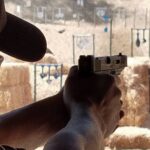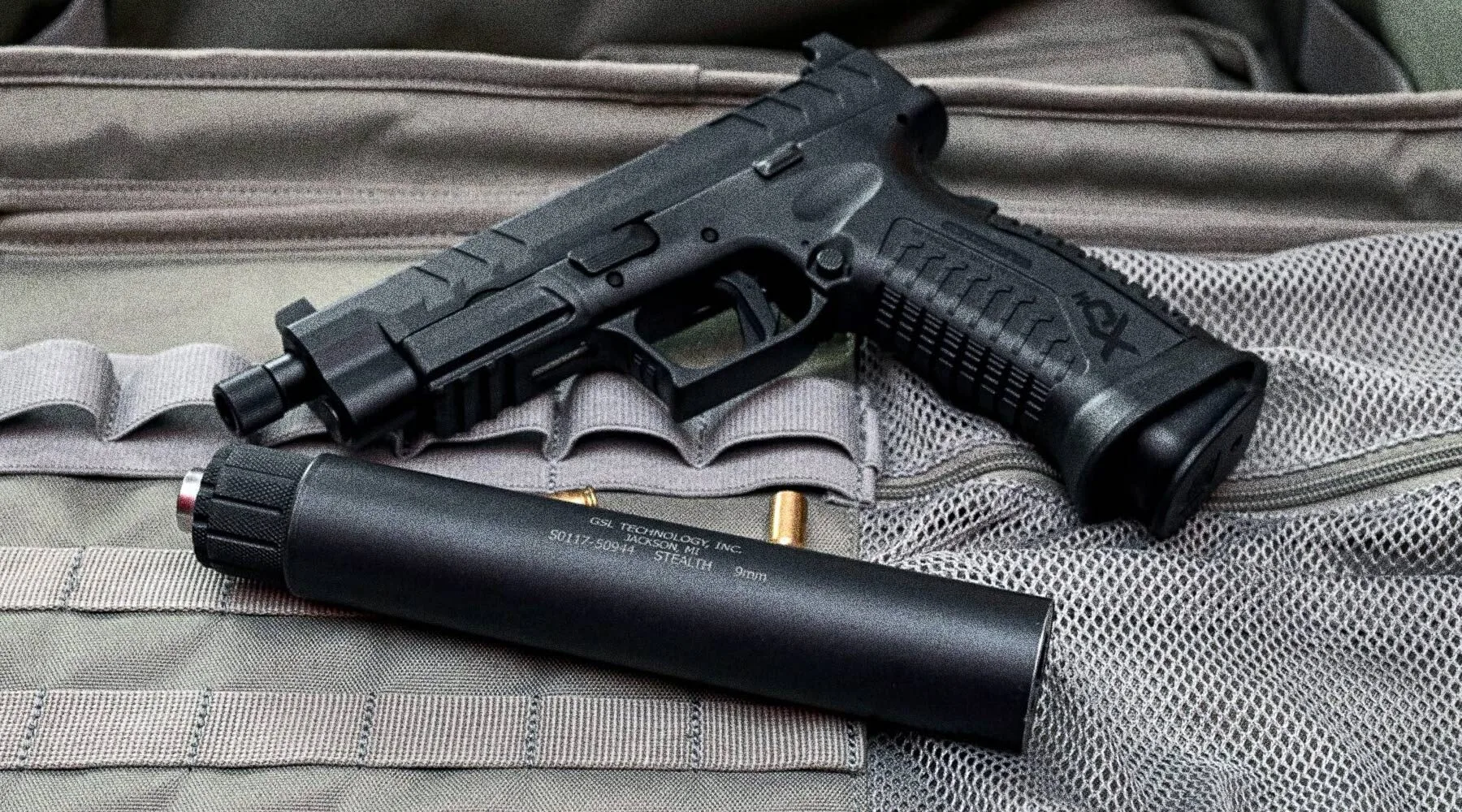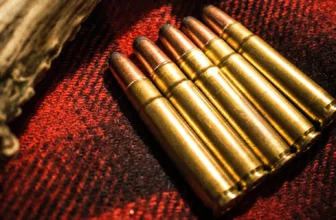TL;DR: .22lr vs 9mm
9mm hits 3-4x harder than 22lr and tends to have about 8-14 times more free recoil energy. 9mm is for defense and competition while 22lr is usually reserved for practice, training, plinking and small varmint hunting.

Not done? Want to know more about how these two cartridges stack up??
Read on to learn more about just how much they differ and the top picks for each based on use case / scenario.
By the end of this guide, you’ll be able to confidently understand where each one falls in the fire-power-pecking-order.
(But First, Real Quick) Here’s A Few Other Relevant Reads:
- Top 9mm Picks for Suppressed Shooting
- Choosing the Best 9mm Ammo for Self-Defense
- Best 9mm Range Ammo And How They Compare
Quick Facts: .22LR Caliber vs 9mm At-a-Glance
| Feature | .22 Long Rifle (.22LR) | 9mm Luger (9x19mm Parabellum) |
|---|---|---|
| Year Introduced | 1887 | 1901 |
| Designer | J. Stevens Arms & Tool Company | Georg Luger |
| Typical Bullet Weights | 30-40 grains (gr) | 115-147 grains (gr) |
| Common Applications | Plinking, Target Practice, Small Game Hunting, Youth Training, Competition | Self-Defense, Law Enforcement, Military, Target Shooting, Competition |
| Case Type | Rimmed, Straight | Rimless, Tapered |
| Primer Type | Rimfire | Centerfire |
Cartridge Specs: A Side-by-Side Technical Look
Understanding the design of a cartridge is key to understanding its capabilities.
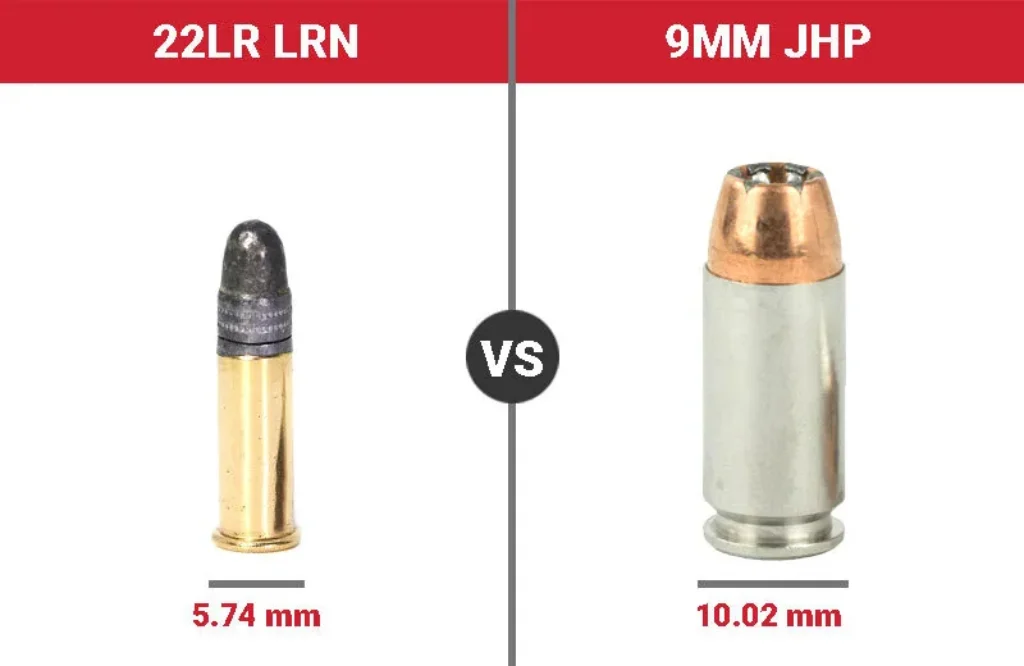
The .22LR and 9mm have very different designs for very different purposes.
The .22LR, developed by J. Stevens Arms & Tool Company in 1887, was designed as a light, manageable round. Its rimmed, straight-walled case is characteristic of rimfire ammunition.
The 9mm Luger, designed by Georg Luger in 1901, was intended for reliable feeding in semi-automatic pistols. Its rimless, tapered case has become a worldwide standard for military and law enforcement.
Here’s a detailed comparison based on SAAMI (Sporting Arms and Ammunition Manufacturers’ Institute) specifications:
| Specification | .22 Long Rifle (.22LR) | 9mm Luger |
|---|---|---|
| Designer | J. Stevens Arms & Tool Co. | Georg Luger |
| Place of Origin | United States | German Empire |
| Designed | 1887 | 1901 |
| Parent Case | .22 Long | 7.65x21mm Parabellum |
| Case Type | Rimmed, straight | Rimless, tapered |
| Bullet Diameter | .223 inches (5.66 mm) | .355 inches (9.02 mm) |
| Neck Diameter | .226 inches (5.74 mm) | .380 inches (9.65 mm) |
| Base Diameter | .226 inches (5.74 mm) | .391 inches (9.93 mm) |
| Rim Diameter | .278 inches (7.06 mm) | .392 inches (9.96 mm) |
| Rim Thickness | .043 inches (1.09 mm) | .050 inches (1.27 mm) |
| Case Length | .613 inches (15.57 mm) | .754 inches (19.15 mm) |
| Overall Length (OAL) | 1.000 inches (25.4 mm) | 1.169 inches (29.69 mm) |
| Max Pressure (SAAMI) | 24,000 psi | 35,000 psi |
These specs directly impact magazine capacity, firearm handling, and ballistic performance.
The 9mm is larger in most dimensions and handles significantly more pressure, contributing to its velocity and energy output.
Spec wise? 9mm crushes the 22lr in any department where you need a larger harder hitting round (but you probably already knew that).
Popular .22LR and 9mm Performance Specs Comparisons
Okay, a few quick notes here:
- Grains are the unit of measure for the actual bullet (projectile) weight. One grain is about 64.79 milligrams or, in other words, 1/7000th of a pound.
- Muzzle velocity (fps) is the velocity (or speed) that the bullet is traveling at as soon as it leaves the actual barrel of your fire arm (aka, the muzzle). As the bullet travels down range, it will decrease in velocity until it hits something or drops to the earth (aka. “bullet drop” – thanks Call of Duty!)
- Muzzle energy (ft/lbs) is essentially the same thing, but is the measure of how “hard” that projectile can “hit” if it met a barrier or object right out the gate. For all of you nerds out there, here’s the equation for that “Muzzle Energy = (Weight in grains x Velocity2 in fps) ÷ 450,240”
The .22LR typically uses bullets weighing between 30 and 40 grains. From a pistol, muzzle velocities can range from about 900 fps to over 1200 fps for high-velocity loads. Rifles can achieve higher velocities due to longer barrels.
The 9mm Luger generally uses heavier bullets, commonly 115 gr, 124 gr, and 147 gr. From a typical 4-inch pistol barrel, 9mm muzzle velocities usually range from 1,000 fps to 1,350 fps.
Okay, now that we got that out of the way, let’s talk about how some of the most popular 9mm ammo choices stack up to some of the most popular 22lr choices, and where it makes sense to use each one.
| Cartridge | Commercial Load Example | Bullet Wt (gr) | Muzzle Velocity (fps) | Muzzle Energy (ft-lbs) | Primary Use-Case |
|---|---|---|---|---|---|
| .22LR | CCI Mini-Mag CPRN – 0030 | 40 | 1235 (rifle) | 135 (rifle) | Plinking, Small Game |
| .22LR | Federal Champion AutoMatch LRN- AM22 | 40 | 1200 (rifle) | 130 (rifle) | Target, Training, Small Game |
| .22LR | Winchester Super-X Power Point HP – X22LRPP1 | 40 | 1280 (rifle) | 145 (rifle) | Varmint, Small Game |
| .22LR | Federal Champion Auto Match – AM22 | 40 | ~1435 (rifle) | ~183 (rifle) | Self-Defense (niche) |
| .22LR | CCI Blazer LRN – 0021 | 40 | 1235 (pistol) | 135 (pistol) | Target, Training |
| 9mm Luger | CCI Blazer Brass FMJ – 5200 | 115 | 1125 (pistol) | 323 (pistol) | Target, Practice |
| 9mm Luger | Federal Premium HST JHP- P9HST1 | 124 | 1150 (pistol) | 365 (pistol) | Self-Defense, LE |
| 9mm Luger | Speer Gold Dot LE Duty JHP- 53618 | 124 | 1150 (pistol) | 327 (pistol) | Self-Defense, LE |
| 9mm Luger | Hornady Critical Defense FTX- 90250 | 115 | 1140 (pistol) | 332 (pistol) | Self-Defense |
| 9mm Luger | PMC Bronze FMJ – 9A-BP | 115 | 1150 (pistol) | 338 (pistol) | Target, Training |
(Data here is approximate and varies by firearm, barrel length, etc. Take it with a grain of salt)
Trajectory (Bullet Drop) Analysis
Quick Note: “Bullet drop” is the vertical distance a bullet falls below the line of sight (the line of aim) due to gravity as it travels through the air. (What goes up must come down.)
Neither the .22LR nor the 9mm are designed for long-range precision, especially from handguns.
Without giving you another huge table to digest, here’s the gist of how bullet drop differs between 9mm and 22lr.
- A .22LR 40gr bullet from a rifle (e.g., CCI Mini-Mag at 1260 fps ) might drop around 8 inches at 100 yards if zeroed at 50 yards. From a pistol, with lower velocity (around 1100 fps ), the drop at 100 yards could be closer to 12 inches. The .22LR is often perceived as “flat” at short ranges due to rifle use, but it loses velocity quickly.
- A 9mm 115gr FMJ from a pistol at 1125 fps, zeroed at 25 yards, might drop about 10-14 inches at 100 yards. A 124gr JHP at 1150 fps could see a similar drop of about 13 inches at 100 yards. This round hits harder further out (obviously).
For typical handgun distances (under 50 yards), both can be effective. The 9mm vs. 22LR trajectory difference matters more when pushing their practical limits. (IDPA / USPSA / or any “hold my beer” moments).
Stopping Power, AKA Lethality
Probably the #1 Question for 22lr vs 9mm.
But first, here’s a gif of Mark Ruffalo to help illustrate this concept.

Thanks Mark. Okay back to it…
“Stopping power” refers to a cartridge’s ability to quickly incapacitate a threat. A super critical factor in self-defense.
When comparing 22 caliber vs. 9mm, the differences are night and day. (But just how much of a difference is there?)
Energy on Target:
The 9mm retains significantly more energy downrange than the .22LR.
- .22LR: A 40gr bullet with ~128 ft-lbs at the muzzle might have only 85-95 ft-lbs at 50 yards, and perhaps 70-80 ft-lbs at 100 yards.
- 9mm: A 124gr bullet with ~365 ft-lbs at the muzzle could retain over 300 ft-lbs at 50 yards and around 260-280 ft-lbs at 100 yards.
Penetration & Expansion:
These are crucial for terminal ballistics. (Terminal ballistics = behavior and effects of a projectile when it hits and transfers its energy to a target.)
- .22LR: Standard .22LR rounds often fail to meet the FBI’s 12-inch minimum penetration depth in ballistic gelatin, especially from handguns. Expansion is pretty minimal with typical plinking rounds. Specialized defensive .22LR loads like Federal Punch aim for better penetration but offer small wound channels. (Still 100% lethal).
- 9mm: Modern jacketed hollow point (JHP) 9mm ammunition is designed for robust performance. Quality loads like Federal HST, Speer Gold Dot, and Hornady Critical Defense aim for optimal penetration (12-18 inches) and reliable expansion, creating much larger wound cavities than a .22LR. (Still 10000% lethal)
The difference in potential tissue damage between a non-expanding .223″ .22LR bullet and a .355″ 9mm JHP that expands to .60″ or more is substantial.
Example Ballistics Gel Test – 22lr (Top) vs 9mm (Bottom)
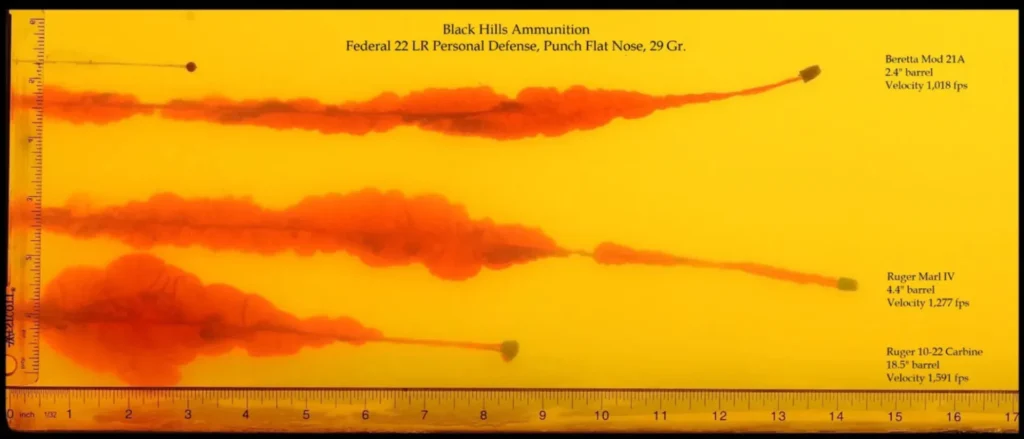
Image Source: https://www.outdoorlife.com/guns/22-lr-for-self-defense-ammunition-test/

Image source: https://www.black-hills.com/shop/new-pistol-ammo/9mm-luger/
You now have the nerdy answer to why this is a key reason the 9mm is favored for self-defense.
Sectional Density & Momentum:
- Sectional Density (SD): Higher SD generally correlates with better penetration.
- .22LR (40gr): SD ≈ 0.143
- 9mm (124gr): SD ≈ 0.141
- 9mm (147gr): SD ≈ 0.167 While a 124gr 9mm has a similar SD to a 40gr .22LR, the 9mm’s greater velocity, energy, and JHP design enable more effective penetration.
- Momentum (mass x velocity): Relates to the bullet’s ability to push through a target.
- .22LR (40gr at 1100 fps): Momentum ≈ 6.28 lb-ft/s
- 9mm (124gr at 1150 fps): Momentum ≈ 20.35 lb-ft/s The 9mm has over three times the momentum of a typical high-velocity .22LR from a pistol, aiding in barrier penetration.
Bottom line there?
The 9mm offers superior stopping power due to higher energy, deeper penetration, reliable expansion with JHPs, and greater momentum.
It’s at least x3 times harder hitting than 22lr. (Cue the Zoolander quotes).

Note: Don’t use 9mm on small varmint or you’re going to explode that thing. (So, not much left for small game furs or meat if that’s what you’re after.)
22lr vs 9mm Recoil
Recoil is the backward thrust experienced when a gun is fired. This is a major differentiator in the .22 vs. 9mm choice. Let’s look at just how much they differ… (It’s a lot. But not a lot-a lot.)
- .22LR: Known for extremely mild recoil. The light bullets and small powder charges result in a gentle push, easily managed by almost anyone. Ideal for learning fundamentals and extended, fatigue-free practice. (Again, still 100% lethal).
- 9mm: Recoil is noticeably greater but generally manageable with proper technique. Often described as “snappy,” it can surprise new shooters, especially in smaller handguns. However, it’s a good balance of power and controllability compared to larger handgun calibers.
Free Recoil Energy (Simplified Comparison):
- .22LR (e.g., Ruger Mark IV pistol): Very Low (often < 0.5 ft-lbs)
- 9mm (e.g., Glock 19 pistol): Moderate (typically 4-7 ft-lbs)
The 9mm can have roughly 8-14 times more free recoil energy than a .22LR in typical handguns.
This is why practicing is super important for faster follow up shots when not in range settings. (Aka, when you need it the most and not overcompensating is critical.)
PS: Check out our top 9mm defense ammo picks guide here
.22LR and 9mm Practical Uses
We’ve already covered so much ground, but where does it make sense to use .22LR and 9mm respectively?
Peep this table to get the quick facts so you know what round gets it done the best.
| Scenario | Prefer .22 Long Rifle (.22LR) | Prefer 9mm Luger | Why |
|---|---|---|---|
| Home Defense | A backup if no other option; for extremely recoil-sensitive individuals. Shot placement is critical. | Strongly Preferred. | 9mm offers far superior stopping power, penetration, and reliable expansion with JHP rounds. Higher capacity is also common. |
| Concealed Carry (CCW) | Very niche; for those who absolutely cannot manage 9mm recoil. Use specialized ammo. | Overwhelmingly Preferred. | 9mm provides a much better balance of power, capacity, and manageability in compact CCW handguns. Wide availability of effective JHP ammunition. |
| Small-Game Hunting | Strongly Preferred. | Not generally recommended. | .22LR offers sufficient power for small game (squirrels, rabbits) without excessive meat damage. Accurate in rifles. 9mm is overkill. |
| Range/Plinking/Training | Excellent Choice. | Good for realistic defensive practice. | .22LR is significantly cheaper, allowing more practice. Very low recoil is ideal for skill-building and new shooters. 9mm for practicing with your defensive caliber. |
| Competition | Rimfire divisions (Steel Challenge, NRA Bullseye). | Dominant in many centerfire action pistol sports (USPSA, IDPA). | .22LR is perfect for specific rimfire competitions. 9mm is popular in dynamic shooting sports due to its balance of power factor, capacity, and manageable recoil. |
| Law Enforcement/Military | Historically used for training; some specialized applications. | Standard Issue for many. | 9mm meets performance requirements for duty use, including barrier penetration and stopping power. Reliability in service pistols. |
| New Shooters | Often the first choice for introduction. | Can be introduced after fundamentals are learned with .22LR. | Extremely low recoil and noise of .22LR build confidence and help teach fundamentals without flinching. |
| Varmint Control | Good for smaller varmints (rats, gophers) at appropriate distances. | Generally too much for smaller varmints, not ideal for larger ones. | .22LR provides sufficient lethality for small pests with less noise and risk of over-penetration compared to centerfire rounds. |
The question of .22 vs. 9mm for self defense clearly favors the 9mm for most people. However, the .22LR’s role in affordable training and recreation is undeniable.
A Brief History: Origins of the .22LR and 9mm
Understanding the history of the .22LR and 9mm Luger adds context to their modern applications.
Grab a cup of coffee and settle infor all the extra info you probably dont care about.

Origin Stories of .22 LR:
The .22 Long Rifle (LR) was introduced in 1887 by the J. Stevens Arms & Tool Company. It evolved from the .22 Long case, using a heavier 40-grain bullet and an increased powder charge.
Designed as a low-recoil, accurate, and inexpensive round, it quickly became popular for target shooting, small game hunting, and training new shooters.
The 22lr round remains one of the most widely produced cartridges globally.
Development of 9mm Luger:
The 9mm Luger (9x19mm Parabellum) was designed by Georg Luger in 1901. It was an evolution of his earlier 7.65x21mm Parabellum, modified to accept a 9mm diameter bullet.
The 9mm Luger was first adopted by the German Navy in 1904 and the German Army in 1908 for the Luger P08 pistol.
It gained widespread acceptance by European military and police forces and saw increased adoption in the U.S. in the late 20th century with the rise of high-capacity semi-automatic pistols.
FAQs: Answering Common .22LR vs. 9mm Questions
Generally, no. The 9mm offers superior stopping power, penetration, and expansion. A .22LR can be used if it’s the only option, but shot placement is critical.
It has some, but it’s very low compared to defensive calibers like 9mm. It can be fatal, but may not reliably or immediately stop an attacker.
If using .22LR for self-defense, consider rounds designed for maximum penetration from short barrels, like Federal Punch 29gr or CCI Velocitor 40gr.
.22LR pistols are excellent for affordable training, plinking, teaching new shooters, varmint control, and low-recoil practice.
.22LR: No, it’s underpowered for game larger than squirrels or rabbits.
9mm: Generally not a hunting round for larger game, though some jurisdictions may allow 9mm carbines for medium game with specific ammo and ranges. Dedicated hunting calibers are better.
Low energy, potentially shallow penetration, unreliable expansion, and less reliable ignition compared to centerfire.
It can be lethal, but often fails to stop threats quickly unless a central nervous system hit is achieved.
The .22LR is generally recommended for beginners due to its minimal recoil and lower noise.
Bulk Ammunition Stock Up and Save on 22lr and 9mm Ammo
Whether you’re buying .22LR for volume shooting or 9mm for defense and training, purchasing in bulk can offer savings. Check for current deals on case-priced .22LR and 9mm ammunition from top brands.
Jon-Paul (JP) is a seasoned firearms industry professional with over a decade of experience spanning firearms, sport shooting merchandising, and customer service. Passionate about all things 2A, he brings a wealth of hands-on knowledge to the world of firearms and ammunition.
When he’s not working, you’ll likely find JP at the range, diving into the latest ballistics trends, or engaging with the shooting community on forums like AR15.com
Feel free to connect with him to collaborate or chat about anything ammo-related.
